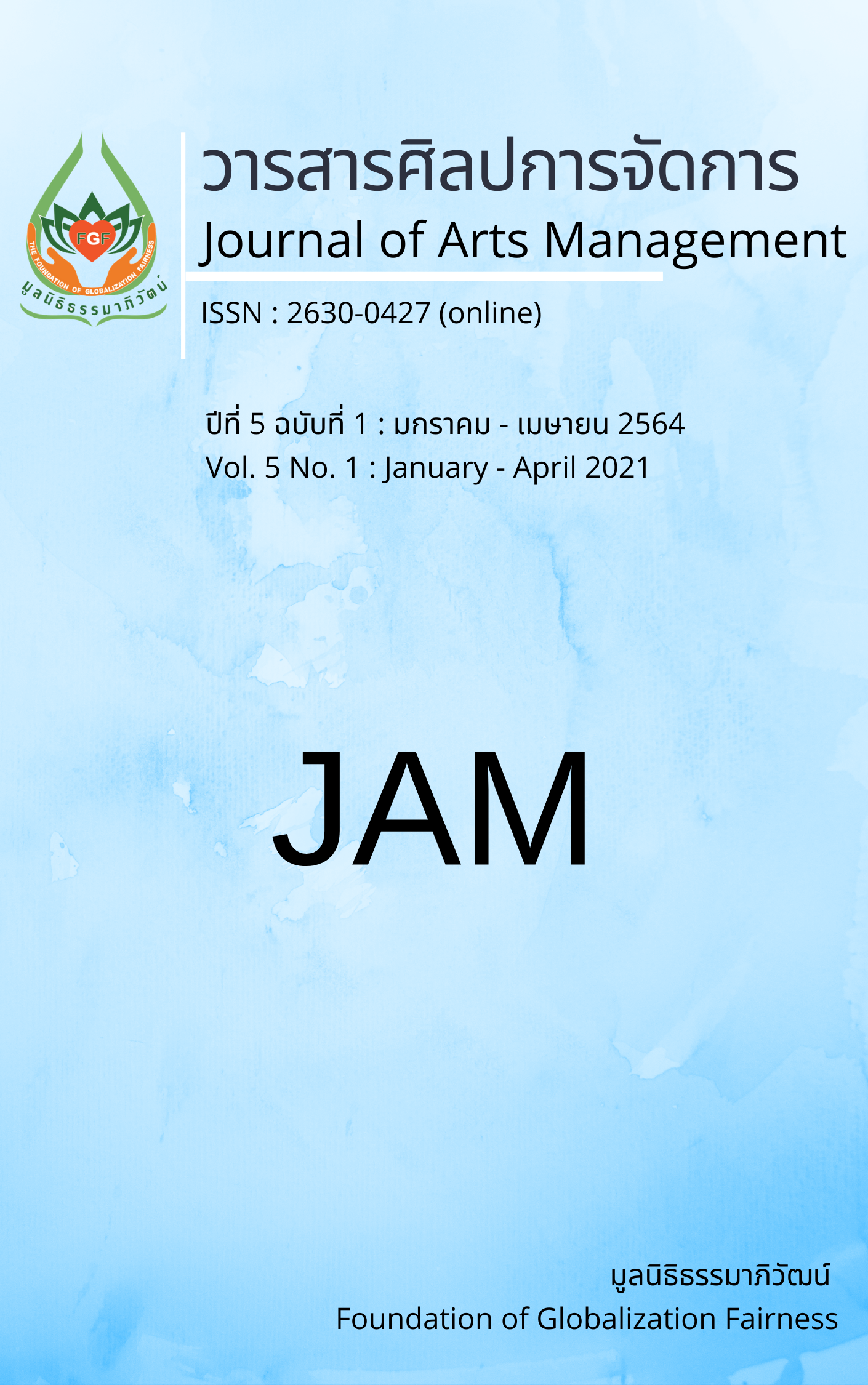The motivation of Online Market Entry among Entrepreneurs in Lampang Province through the Food Panda Application
Main Article Content
Abstract
The purposes of this study were (1) to study the level of opinions on entrepreneurs’ motivation and business growth, and (2) to investigate the influence of motivation among entrepreneurs participating in Food Panda in Lampang Province towards the growth of the business. This study was a quantitative research by using questionnaires as a research tool. The result of the validity was 0.72 and the reliability was 0.96. The population employed with the entrepreneurs who join Food Panda for more than 3 months. A sample was selected from 385 cases were included as a sample selected by purposive sampling. Data analysis was processed by descriptive statistics to find the frequency, percentage, mean, and standard deviations, and applied inferential statistics to analyze simple regression for testing the research hypothesis. The research results were found level of opinions on motivational feedback was at a high level with a mean of 3.86. In addition, the overall level of opinions on the growth of the business was at a high level with a mean of 3.78. The hypothesis test's result was revealed that the motivation influenced the growth of business among entrepreneurs participating in the Food Panda application with the correlation coefficient equal to 0.74 with statistically significant at 0.05 level.
Article Details
Views and opinions appearing in articles in the Journal of Arts of Management It is the responsibility of the author of the article. and does not constitute the view and responsibility of the editorial team I agree that the article is copyright of the Arts and Management Journal.
References
เกตุวดี สมบูรณ์ทวี. (2561). ปัจจัยด้านคุณภาพการบริการที่มีอิทธิพลต่อการตัดสินใจซื้อซ้ำผลิตภัณฑ์อาหารผ่านผู้ให้บริการ “Food Panda Application”. วารสารการจัดการสมัยใหม่, 16(1), 153-162.
จุฑารัตน์ ตามกลาง, ศศิธร พลอยฉิมพลี, อังคณา กุลสุวรรณ์, อนุชิต กล้าไพรี และวิมลยา เนื้อทอง. (2562). แรงจูงใจในการใช้บริการศูนย์อาหารของนักศึกษามหาวิทยาลัยราชภัฏนครราชสีมา. วารสารวิจัยวิทยาศาสตร์และเทคโนโลยี มหาวิทยาลัยราชภัฏนครราชสีมา, 4(1), 28-43.
ณัฐศาสตร์ ปัญญานะ และวัชรพจน์ ทรัพย์สงวนบุญ. (2562). ปัจจัยที่มีผลต่อการตัดสินใจใช้บริการอาหารตามสั่งแบบจัดส่ง. วารสารเศรษฐศาสตร์และบริหารธุรกิจ มหาวิทยาลัยทักษิณ, 11(1), 53-66.
นุจรี ปันแสน และบุญญรัตน์ สัมพันธ์วัฒนชัย. (2561). แรงจูงใจในการลงทุนของผู้ประกอบการโรงแรมบูติกในเขตอำเภอหัวหิน – ชะอำ. วารสารวิทยาลัยดุสิตธานี, 12(3), 185-200.
ประจักษ์ กึกก้อง, นันท์ธณปกรณ์ แสงสม, ปนัดดา ปิ่นโตนด, ปฏิภาน อภิชัยนภากุล และนครินทร์ นามบุตร. (2562). ความสำคัญของปัจจัยทัศนคติ แรงจูงใจ และส่วนประสมทางการตลาดของนักศึกษาที่บริโภคชานมไข่มุก มหาวิทยาลัยราชภัฏกำแพงเพชร จังหวัดกำแพงเพชร. รายงานสืบเนื่องจากการประชุมวิชาการระดับชาติ ครั้งที่ 6 วันที่ 20 ธันวาคม 2560 สถาบันวิจัยและพัฒนา มหาวิทยาลัยราชภัฏกำแพงเพชร, 1069-1075.
พิทักษ์ ศิริวงษ์, จักริน พงษ์ศรี และนพดล อ่ำสะอาด. (2560). ประสบการณ์ความสำเร็จผู้ประกอบการระบบการจัดการร้านอาหาร กรณีศึกษา Food Story บริษัท ลิฟวิ่งโมบาย จำกัด. การประชุมเสนอผลงานวิจัยระดับบัณฑิตศึกษา ครั้งที่ 2 วันที่ 20 มกราคม 2560 ณ มหาวิทยาลัยราชภัฏมหาสารคราม (RMU Graduate Research Conference, 2017), 88-96.
ศูนย์วิจัยกสิกรไทย. (2562). บทวิเคราะห์แนวโน้มธุรกิจ: การแข่งขันของแอพพลิเคชั่นสั่งอาหารดันธุรกิจ Food Delivery เติบโตต่อเนื่องคาดมีมูลค่าสูงถึง 33,000 – 35,000 ล้านบาท ในปี 2562. สืบค้นจาก https://www.kasikornresearch.com/th/analysis/k-econ/business/Pages/z2995.aspx
สุชาติ ไตรภพสกุล. (2558). อิทธิพลของปัจจัยแรงจูงใจต่อการเป็นผู้ประกอบการที่มีต่อการเติบโตและความมุ่งหวังที่จะเติบโตของธุรกิจ: กรณีศึกษาประเทศไทย. วารสารสุทธิปริทัศน์, 29(90), 75-93.
สำนักงานพัฒนาธุรกรรมทางอิเล็กทรอนิกส์. (2560). พฤติกรรมผู้ใช้อินเทอร์เน็ตในประเทศไทย ปี 2558-2559. สืบค้นจาก http://dspace.bu.ac.th/bitstream/123456789/2478/1/jidapa_thad.pdf
Baum, J. R., Locke, E. A. & Smith, K. G. (2001). A multidimensional Model of Venture Growth. Academy of management Journal, 44(2), 292-303.
Carneiro, A. (2007). What is required for growth. Business Strategy Series, 8(1), 51-57.
Cochran, W. G. (1977). Sampling Techniques. (3rd ed.). New York: John Wiley & Sons.
Daft, R. L. (2000). Management. (5th ed.). Fort Worth: Dryden.
Krueger, F. N. & Brazeal, V. D. (1994). Entrepreneurial Potential and Potential Entrepreneurs. Entrepreneurship and Practice, 18, 91-104.
Kuratko, D. F. (2005). The Emergence of Entrepreneurship Education: Development, Trends and Challenges. Entrepreneurship Theory and Practice, 29(5), 577-598.
Maslow, A. H. (1954). Motivation and Personality. New York: Harper and Row Publishers.
Mason, G., Bishop, K. & Robinson, C. (2009). Business growth and innovation: The wider impact of rapidly growing firms in UK city-regions. London: NESTA.
McKelvie, A. & Wiklund, J. (2010). Advancing Firm Growth Research: A Focus on Growth Mode Instead of Growth Rate. Entrepreneurship Theory and Practice, 34(2), 261-288.
Mescon, T. & Montanari, J. (1981). The personalities of independent and franchise entrepreneurs: An empirical analysis of concepts. Journal of Enterprise Management, 3(2), 149-159.
Saloma, S. & Brinckmann, J. (2008). Functional Management Competence and Growth of Young Technology-Based Firms. Creativity and Innovation Management, 17(3),186-203.
Schumpeter, J. A. (1934). The Theory of Economic Development. Cambridge: Harvard University Press.


